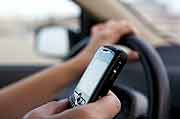
MONDAY, April 27, 2015 (HealthDay News) — A smartphone app that cuts off teenagers’ cell service when they turn on the car ignition may help reduce their accident risk, a preliminary new study suggests.
Teens appreciate full well that texting is risky, said study lead author Dr. Beth Ebel, an associate professor of pediatrics at the University of Washington School of Medicine. “And they, like all of us, almost uniformly know that it’s illegal to text while driving, and yet still there’s the compulsion to do it. So it’s kind of a great challenge for public health.”
Her research team wondered if there was a feasible way for technology “to basically stop the bell from ringing,” Ebel said. That led to this experimental device that blocks cellphone transmission once the car starts.
The results of Ebel’s investigation are scheduled for presentation Monday in San Diego at the annual meeting of the Pediatric Academic Societies. Research presented at meetings is usually considered preliminary until published in a peer-reviewed medical journal.
According to the U.S. Centers for Disease Control and Prevention, which funded this study, car crashes are the leading cause of accidental death among American teens, with phone use behind the wheel raising teen accident risk by roughly 24 times.
“Learning to drive is a complicated and complex task that involves trying to navigate and pay attention and gauge distance and speed,” Ebel said. “And for the new driver, cellphones complicate that learning process.”
One low-tech way parents can intervene, Ebel suggested, “is to simply have a contract with your children that makes clear that your expectation is that they not pick up the phone while they’re in the car.”
But most kids with smartphones have an almost innate habit of responding when the phone rings, she said.
So the study team set out to remove the possibility of phone use in a car setting altogether.
For the study, investigators divided 29 drivers between 15 and 18 years of age into three groups that were followed for six months.
Cars driven by the first group were left as is, while the second group’s cars were outfitted with a video camera mounted to the rearview mirror and linked to an accelerometer. The bi-directional camera kept an interior/exterior record of all high-risk driving “events,” such as sudden braking or swerving, for later parental/driver review.
The third group’s cars were outfitted with the camera plus a programmable device that blocked all calls and texts on smartphones linked via app to the car’s ignition. Ebel said the phone-block device and app are inexpensive and widely commercially available. The camera device is sometimes provided by car insurance companies for free to new drivers, she noted.
Teens who drove cars outfitted with either the camera alone or the camera plus the phone-blocking technology saw their frequency of high-risk driving events drop by almost 80 percent, the researchers found.
Also, phone-related high-risk events seemed to drop the most among teens whose phones were blocked. However, the study’s small size meant this observation did not reach “statistical significance.”
Speaking on behalf of the Governors Highway Safety Association, communications director Kara Macek said that “anything that can drive down risky behavior and steer [teens] toward internalizing safe driving habits is a positive.”
At the same time, she added, “parents truly hold the key” when it comes to harnessing technology for safety purposes.
“The more we can get parents to implement these new technological tools and really engage in the process with their novice drivers, the greater chance we have of preventing teen driver crashes and the resulting injuries and fatalities,” Macek said.
But technology is not a cure-all, Macek added. “Ultimately, it comes down to teen drivers taking the responsibility for themselves,” she said.
More information
There’s more on teen driving and safety at the National Safety Council.
Copyright © 2025 HealthDay. All rights reserved.

